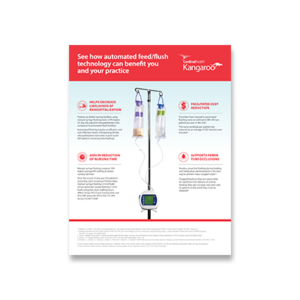See how automated flush technology can benefit you and your practice
Helps decrease likelihood of rehospitalization
3.9%
higher rehospitalization rate over 30 days when not using automated hydration.1
Aids in reduction of nursing time
14%
decrease in workload daily.2

Supports fewer tube occlusions reduction
Automated hydration is the most effective way to prevent tube clogging.4,5
Facilitates cost reduction
More than
$100
saved on average per patient, per year.3
Webinar:
Hydration: An Essential Component
of Enteral Nutrition Therapy
throughout the Life Cycle
September 20, 2023
Webinar:
Maximizing Hydration
as an Enteral Nutrition
Tool
November 17, 2022
Resources

Maximizing Hydration as an Enteral Nutrition Tool, webinar recording

Unites States Hospital Inpatient Admissions with Dehydration and/or Malnutrition in Medicare Beneficiaries Receiving Enteral Nutrition: A Cohort Study

Flush Now: The Use of Technology to Prevent Occlusions in Jejunal Feeding Tubes – A Pilot Evaluation

Automated Feed/Flush
1. Nadeau B, Tordella J. The role of automated flushing in decreased 30-day rehospitalization rates. Poster presented at: ASPEN’s Clinical Nutrition Week; Feb 2017; Orlando, FL.
2. Nadeau B, Weissbrod R, Trierweiler-Hauke B. Flush now: The use of technology to prevent occlusions in jejunal feeding tubes – a pilot evaluation. Poster presented at: ESPEN Congress; Sep 2017; The Hague, The Netherlands.
3. Torres R, Nadeau W, Saunders R. Does automating water flushes impact the care costs of enteral nutrition therapy? Poster presented at: ESPEN Congress; Sep 2018; Madrid, Spain.
4. Parrish, C. R. Clogged feeding tubes: A clinician’s thorn. Practical Gastroenterology. 2014; 1-16.
5. Boullata, J. I., Carrera, A. L., Harvey, L., Hudson L., McGinnis C., Wessel J. J., Guenter, P. ASPEN Safe practices for enteral nutrition therapy. Journal of Parenteral and Enteral Nutrition. 2017; 41(1), 15-103.

